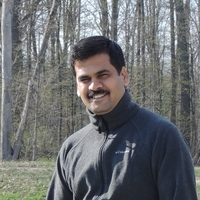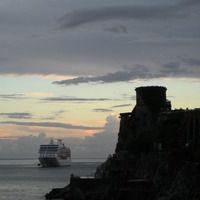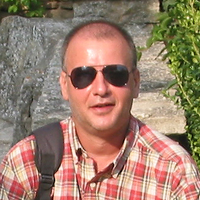Papers by Guttorm Christensen
Science of The Total Environment

Seasonality in biomagnification of persistent organic pollutants (POPs; polychlorinated biphenyls... more Seasonality in biomagnification of persistent organic pollutants (POPs; polychlorinated biphenyls, chlorinated pesticides, and brominated flame retardants) in Arctic marine pelagic food webs was investigated in Kongsfjorden, Svalbard, Norway. Trophic magnification factors (TMFs; average factor change in concentration between two trophic levels) were used to measure food web biomagnification in biota in May, July, and October 2007. Pelagic zooplankton (seven species), fish (five species), and seabirds (two species) were included in the study. For most POP compounds, highest TMFs were found in July and lowest were in May. Seasonally changing TMFs were a result of seasonally changing POP concentrations and the d15N-derived trophic positions of the species included in the food web. These seasonal differences in TMFs were independent of inclusion/exclusion of organisms based on physiology (i.e., warm- versus cold-blooded organisms) in the food web. The higher TMFs in July, when the food web consisted of a higher degree of boreal species, suggest that future warming of the Arctic and increased invasion by boreal species can result in increased food web magnification. Knowledge of the seasonal variation in POP biomagnification is a prerequisite for understanding changes in POP biomagnification caused by climate change.

The report summarises the principles and regulations given in the EC Water Framework Directive (W... more The report summarises the principles and regulations given in the EC Water Framework Directive (WFD) and the corresponding CIS-guidance documents (Common Implementation Strategy). In addition the reports gives the main findings from two EU-projects under DG-Research; the FAME project dealing with assessment of fish status, and the MANTRA EAST project dealing with water management of trans-boundary water bodies. 4 keywords, Norwegian 4 keywords, English 1. Vannressursforvalning 1. Water Resources Management 2. EU-reguleringer 2. EU-regulations 3. Fiskeforvaltning 3. Fish Management 4. Grensevassdrag 4. Bordering Rivers Dag Berge Stig A. Borgvang Øyvind Sørensen Project manager Research manager Responsible ISBN 82-5774699-1 Norwegian Institute for Water Research Oslo Akvaplan-niva Tromsø Management of Freshwater Fisheries on Bordering Rivers EU-regulations in the field of Water and Fish Management Oslo 2005-04-05 Project leader: Dag Berge, NIVA Co-worker: Geir Dahl-Hansen, Akvaplan-ni...

Marine Ecology Progress Series, 2021
Climate change is impacting ice-affiliated marine mammal habitats throughout the Arctic, with sea... more Climate change is impacting ice-affiliated marine mammal habitats throughout the Arctic, with sea ice declines reducing traditional haul-out and breeding habitats, putting a premium on alternative useable areas. In the Arctic, ice forms early in the season and is retained late into the spring in coastal lagoons, but little information is available regarding how this nature type is used by marine mammals. This study documents use of a lagoon by 20 ringed seals tracked for an average of 188 d via satellite-linked GPS tags. Overall, tagged seals spent 8.9 ± 0.4% (±SD) of their time per day inside the lagoon, with strong summer and autumn peaks that dropped off in winter and ceased in spring. Inside the lagoon, seals spent significantly larger proportions of their time hauled out and less time diving in comparison to when they were outside the lagoon. Additionally, the seals dove deeper (19 vs. 7 m) and for longer periods (4 vs. 2.5 min) when outside the lagoon, indicating that most fee...
Organohalogen Compounds, 2001
Environmental Science & Technology

This report examines the human impact on the subarctic environment of the joint border area of No... more This report examines the human impact on the subarctic environment of the joint border area of Norway, Finland and Russia. The aim is to present the current state and recent changes that have taken place in the region. The main threat to the environment is the Pechenganikel mining and metallurgical industrial combine in the towns of Nikel and Zapolyarny in the Kola Peninsula. Emissions from this complex include high levels of heavy metals, persistent organic pollutants and sulfur dioxide. Pollution, along with climate change, water level regulation and other anthropogenic effects, has affected the aquatic ecosystems in the joint border area. The main heavy metals in the area are copper and nickel, the highest concentrations of which are measured near the combine. Direct discharge of sewage into the river continues and airborne heavy metal particles are also deposited to areas farther away. Climate changeinduced increase in temperature and precipitation in the Kola Peninsula is evident. Water level regulation with seven hydropower plants in the Pasvik River have changed it into a series of lakes and lake-like reservoirs. This report discusses modelling, which was enabled to estimate the effect of climate change on Lake Inarijärvi and the Pasvik River hydrology, water level fluctuation and ecology and to follow the sulfur dioxide emissions emitted from the Pechenganikel. Effects of pollution on the nature and concentrations of the main pollutants were studied and climate change in the border area and its effects on the ecology were estimated. Also the effects of water level regulation on the ecological status of the aquatic ecosystems were addressed.

Frontiers in Marine Science, 2022
The red king crab (RKC, Paralithodes camtschaticus) was introduced to the southern Barents Sea in... more The red king crab (RKC, Paralithodes camtschaticus) was introduced to the southern Barents Sea in the 1960s with the aim to develop a new, commercially attractive stock of the species. In the subsequent decades, the stock has indeed become abundant and widespread, but the species’ presence also implies intense predation on benthic biota and thereby severe degradation of benthic ecosystems. Our capacity to monitor and harvest the species efficiently is therefore imperative. Yet, fishermen report highly variable catches despite little variation in the timing and location of fishing, possibly induced by the species’ migratory behavior, which makes the search for crab aggregations time consuming and expensive. Previous studies have shown that the RKC is capable of conducting long-distance migrations, and suggest that the species conduct seasonal migrations between shallow (winter- and springtime) and deep waters (summer and autumn). Here, we applied telemetry to investigate the migrator...

Data in Brief, 2022
Acoustic telemetry allows for high-resolution, long-term tracking of moving animals. Here, we des... more Acoustic telemetry allows for high-resolution, long-term tracking of moving animals. Here, we describe data on the movement patterns of 37 adult red king crab (RKC, Paralithodes camtschaticus) obtained by means of acoustic telemetry. Acoustically tagged RKC were released in Gamvikfjorden (Sørøya, northern Norway) the 24th of May 2016 and tracked until the 1st of November 2016. Individual crabs resided in the fjord for 1–162 days and were recorded 16 - 11,501 times (mean number of records per crab: 2,851). In total, the data set consist of 105,484 pairs of accurate spatio-temporal coordinates. The acoustic receivers (n = 38) deployed close to the seabed were integrated with temperature sensors that continuously recorded the ambient seawater temperature, resulting in 174,154 water temperature recordings. These novel tracking data can be used to investigate the species' migratory behaviour, spatio-temporal habitat selection, and the relative role of their environment and their possible food sources. Moreover, the high-resolution seawater temperature dataset may serve independently as input data in physical-oceanographic models of this sub-Arctic sill fjord.

Ecology of Freshwater Fish, 2020
Recent large influxes of non‐native Pacific pink salmon (Oncorhynchus gorbuscha) to North Europea... more Recent large influxes of non‐native Pacific pink salmon (Oncorhynchus gorbuscha) to North European rivers have raised concern over their potential negative impacts on native salmonids and recipient ecosystems. The eggs and carcasses of semelparous pink salmon may provide a significant nutrient and energy subsidy to native biota, but this phenomenon has not been widely documented outside the species' native distribution. We analysed the stomach contents and stable isotope values (δ15N and δ13C) in muscle and liver tissues of juvenile Atlantic salmon (Salmo salar) and brown trout (Salmo trutta) to determine whether these native salmonids utilise marine‐derived nutrients and energy provided by pink salmon eggs and carcasses in the subarctic river system Vesterelva, northern Norway. Although egg foraging and assimilation of marine‐derived nutrients in fish body tissues were found to be minor at the population level, a few juvenile salmon and trout had recently eaten large quantities...

This is chapter 6 of the State of Environmental Science in Svalbard (SESS) report 2020 (https://s... more This is chapter 6 of the State of Environmental Science in Svalbard (SESS) report 2020 (https://sios-svalbard.org/SESS_Issue3). Coastal waters are among the most productive regions in the Arctic. These nearshore waters are critical breeding and foraging grounds for many invertebrates, fish, birds, and marine mammals and provide a host of ecosystem services, from private outdoor activities to large-scale tourism and fisheries. Arctic nature coast types (= coastscapes) and biodiversity are under growing pressure as climate change and human activities increase in the region. More data on the rates of change in the physical, chemical and biological environments in these highly dynamic and heterogeneous coastscapes are urgently needed. Svalbard is warming more rapidly than anywhere else in the Arctic, and the Arctic is warming at 2-3 times the rate of other areas globally. Svalbard experiences steep climate gradients due to being at the interface between warm Atlantic and cold Arctic wat...
Ottar
Norge er en av få nasjoner i verden som tillater undersjøisk deponering av avgangsmasser fra gruv... more Norge er en av få nasjoner i verden som tillater undersjøisk deponering av avgangsmasser fra gruvedrift. Tidligere tiders filosofi basert på "ute av syne, ute av sinn" er imidlertid ikke et argument som fungerer i dagens samfunn. Det har derfor vært et sterkt fokus på kunnskapsinnhenting knyttet til hvordan slik deponering påvirker marint miljø de senere år.

The Forest Service of the U.S. Department of Agriculture is dedicated to the principle of multipl... more The Forest Service of the U.S. Department of Agriculture is dedicated to the principle of multiple use management of the Nation's forest resources for sustained yields of wood, water, forage, wildlife, and recreation. Through forestry research, cooperation with the States and private forest owners, and management of the national forests and national grasslands, it strives-as directed by Congress-to provide increasingly greater service to a growing Nation. The U.S. Department of Agriculture (USDA) prohibits discrimination in all its programs and activities on the basis of race, color, national origin, age, disability, and where applicable, sex, marital status, familial status, parental status, religion, sexual orientation, genetic information, political beliefs, reprisal, or because all or part of an individual's income is derived from any public assistance program. (Not all prohibited bases apply to all programs.) Persons with disabilities who require alternative means for communication of program information (Braille, large print, audiotape, etc.) should contact USDA's TARGET Center at (202) 720-2600 (voice and TDD). To file a complaint of discrimination, write USDA, Director, Office of Civil Rights, Room 1400 Independence Avenue, SW, Washington, DC 20250-9410 or call (800) 795-3272 (voice) or (202) 720-6382 (TDD). USDA is an equal opportunity provider and employer.










Uploads
Papers by Guttorm Christensen